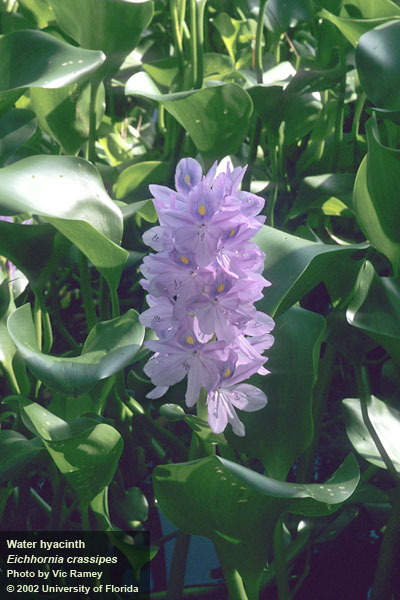
by Libbie Johnson | Feb 24, 2016
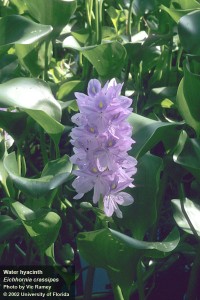 Libbie Johnson
Libbie Johnson
UF IFAS Escambia County Extension
Northwest Florida can be a pond owner’s paradise. There is usually enough rainfall to keep ponds filled, catfish, bass, and brim are well adapted to the environmental conditions, and there is a long season to catch fish.
One of the biggest problems pond owners face is the constant struggle with pond vegetation. Some pond vegetation is good. It provides a cover for young fish, helps stabilize the shoreline or bank, and some vegetative species are attractive wildlife.
However some species are highly invasive and can completely overtake a pond. One such species is water hyacinth (Eichhornia crassipes).
The water hyacinth is a floating plant, which if left unchecked and allowed to grow to its maximum potential, can weigh up to 200 tons per acre of water. In rivers, it can choke out other vegetation and make navigation difficult to impossible.
Water hyacinth, as an ornamental plant, is a wolf in sheep’s clothing. The plants intertwined and form huge floating mats which can root on muddy surfaces, as seen in the photo below.
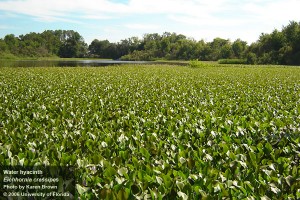
The plant will be several inches tall, has showy lavender flowers, with rounded, shiny, smooth leaves. These leaves are attached to spongy stalks that help keep the plants afloat. The prolific roots are dark and feathery.
In Northwest Florida this pest commonly dies back in the winter. Unfortunately it is able to regrow when the weather and water warm.
Water hyacinth is not a native species. It is believed to have been introduced into the U.S. in 1884 at an exposition in New Orleans. Within 70 years of reaching Florida, the plant covered 126,000 acres of waterways (Schmitz et al. 1993).
Water hyacinth is on the FL DACS Prohibited Aquatic Plant List – 5B-64.011. According to Florida Statute 369.25, “No person shall import, transport, cultivate, collect, sell, or possess any noxious aquatic plant listed on the prohibited aquatic plant list established by the department without a permit issued by the department.”
To control a small infestation, the plants can be gathered from the surface, brought to the shore, left to dry and then disposed of in the garbage. There are biological control options—water hyacinth weevils will be useful in keeping the plant populations down.
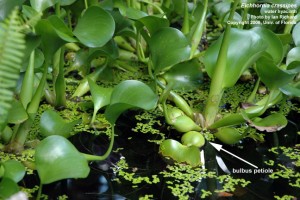
The spongy petiole helps keeps the plant afloat.
Finally, chemical herbicide options may be the best alternative. University of Florida Aquatic Vegetation Specialist, Dr. Langeland, wrote Efficacy of Herbicide Active Ingredients Against Aquatic Weeds, a good publication that will help you to determine which herbicide will work best for different weeds.
NOTE: The middle of the summer is generally not the ideal time for applying herbicide on pond vegetation. For more information on weed control in Florida ponds, please see Weed Control in Florida Ponds. If you have any questions about identifying a pond weed, contact your local county Extension agent.
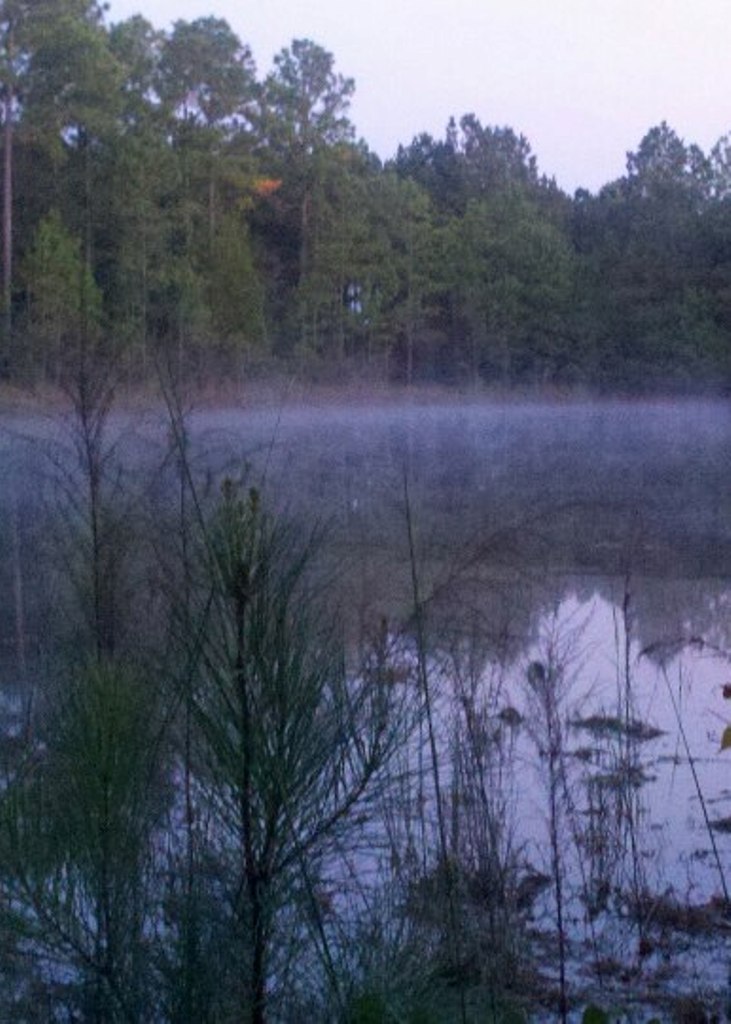
by Jennifer Bearden | May 1, 2015

Photo by Jennifer Bearden
These days many ponds are just backyard recreational ponds. Management goals vary from owner to another. Some pond owners want very little productivity (very little fish removed). They want little vegetation with just a few fish. This pond is just meant for relaxation and aesthetics. Other pond owners want to fish every once in a while but primarily just want to enjoy the wildlife that’s attracted to it. And then others want to manage their ponds for great fishing whether it’s trophy bass, trophy bluegill or just a good balance of the two.
Each goal has very different management practices associated with it. When a pond owner asks about a management practice like fertilization, my first question to them is, “What is your goal for the pond?”
For a pond that is just for aesthetics with maybe a little fishing, I would recommend not fertilizing it. Once pond fertilization has started abruptly stopping this practice can lead to fish kills and re-establishment of rooted plants across the bottom.
When nutrients are added into a pond, they eventually make their way into fish tissue. They can be removed from the pond in the form of removing the fish to keep the pond balanced. Also, fertilization increases the number of microscopic plants, phytoplankton, that are suspended in the water. This gives the pond a green color and can block sunlight to rooted plants along the bottom of the pond. Microscopic plants are the bottom of the food pyramid in the pond. An increase in these plants leads to an increase in the number of fish in the pond.
I would only recommend beginning a fertilization program if a pond is going to receive heavy fishing pressure and the pond owner is willing and able to commit to continuing the fertilization program.
The desirable pond pH for fishing is 6.0-8.0. Some panhandle soils are acidic and have a lower pH value. You can raise the pH by adding lime but always test your water pH before adding lime.
Pond owners should monitor the water clarity using a secchi disk. The secchi depth will tell the pond owner if fertilization is needed or if the pond is in need of aeration. Each year, the fertilization program should begin when water temperatures exceed 65°F and end the program when they fall below 70°F. You can read more at Fertilization of Fresh Water Fish Ponds
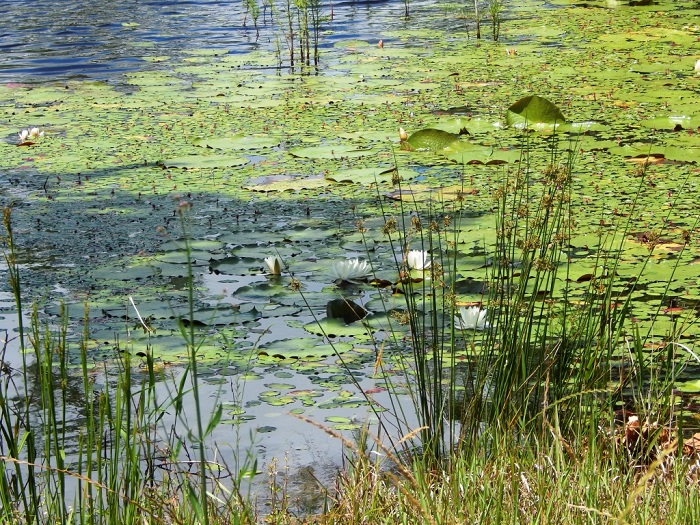
by Mark Mauldin | Apr 17, 2015

Monitor your ponds closely throughout the spring and make any necessary herbicide applications before weed growth becomes too excessive.
Photo Credit: Mark Mauldin
Similar to Goldilocks’ porridge, water temperature doesn’t need to be too hot or too cold, it needs to be just right for using aquatic herbicides (70o – 80o F). Here in Florida, these optimum water temperatures occur in the spring. Water temperature largely regulates the growth of most aquatic weeds; cool temperatures slow or stop growth and warm temperatures promote growth. Keeping this simple principle in mind can help determine when to use aquatic herbicides.
Generally speaking, aquatic herbicides are not used when water temperatures are below 60o F. When water temperatures are this cool most aquatic weeds are not actively growing. For herbicides to be effective the target plants must be actively growing. Applying herbicides too early in the spring is generally not an issue because winter dieback can make many aquatic weeds hard to find when water temperatures are cool. The weeds are out of sight and out of mind. The much more common issue is waiting too long before attempting to control weeds.
As water temperatures climb above 60o weeds begin to grow. Unfortunately, they often times grow unnoticed throughout the spring until they become completely out of control in the summer. By this point, control, even using herbicides, is a monumental task. If at all possible, control weeds early in the growing season.
As plants grow they are able to build up energy reserves, making them more difficult to control. The longer they are allowed to grow the stronger and more difficult to control they become. Controlling weeds earlier in the growing season eliminates this problem.
Similarly, as the growing season progresses plants produce more and more biomass. If an herbicide is applied and the weeds are killed large amounts of decomposing plant material in the water can cause problems. The decomposition process uses oxygen; dissolved oxygen can drop to levels that are hazardous to fish and other aquatic species. The more plant material that is present when herbicides are applied the bigger concern this becomes. Applying herbicides earlier in the growing season, before large amounts of biomass are produced, can help lessen this problem.
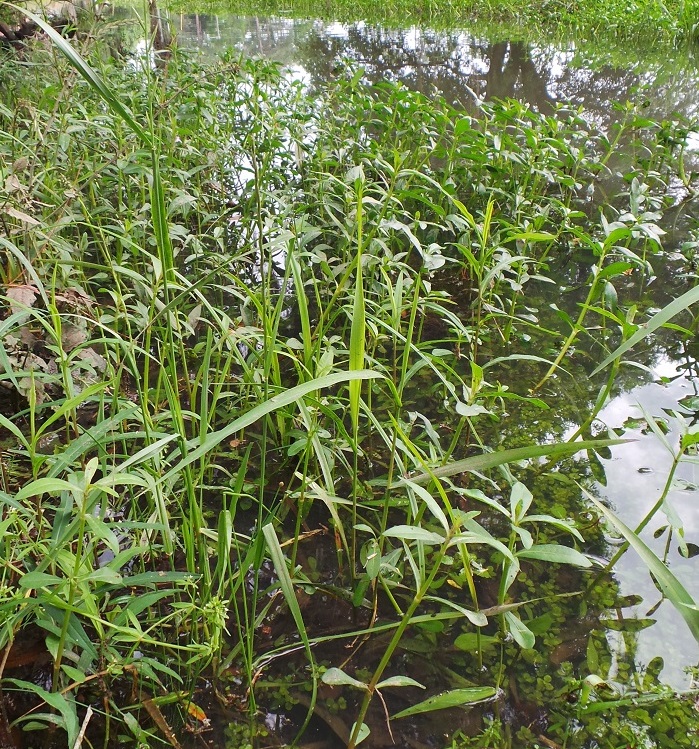
Aquatic weeds can grow rapidly when temperatures are warm. Don’t let them get out of control before you begin control efforts.
Photo Credit: Mark Mauldin
Further compounding the issue, warm water is physically able to hold less dissolved oxygen than cooler water. Late in the summer pond water can be very warm with low concentrations of dissolved oxygen even before large amounts of decomposing plant material are added.
To help reduce the risk of oxygen depletion never treat more than ½ of a pond at one time, if weed growth is already substantial treat no more than 1/3 of a pond at one time and always allow 10 -14 days for oxygen recovery between treatments. Also, avoid treating on cloudy days, another factor that can lead to lowered dissolved oxygen.
Aquatic weed control will be easier and more effective if you monitor your pond throughout the spring and make any needed herbicide applications early, before the weeds have grown too large and the water is too warm. Consult your county extension agent for assistance determining what aquatic weeds you have and if treatment is necessary. Always read and follow all label directions when using any herbicide.








